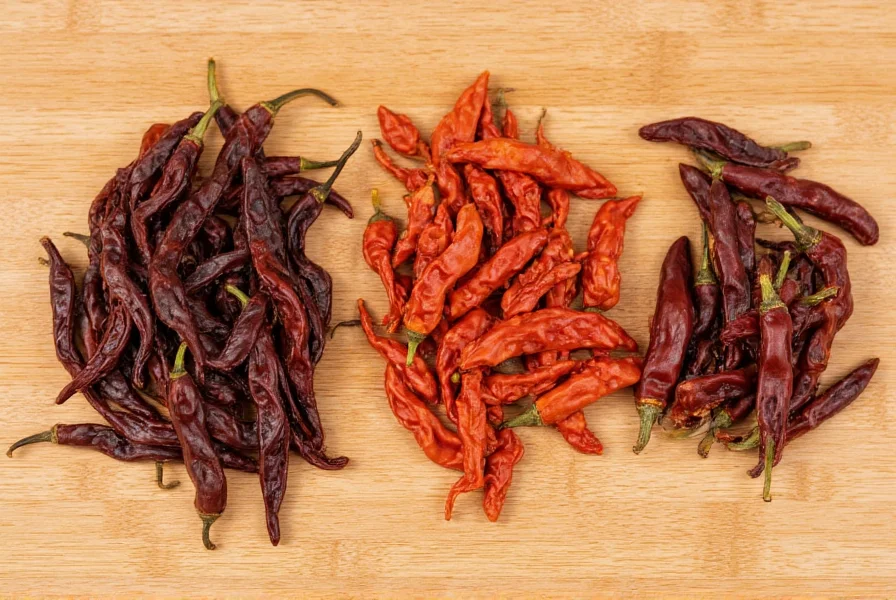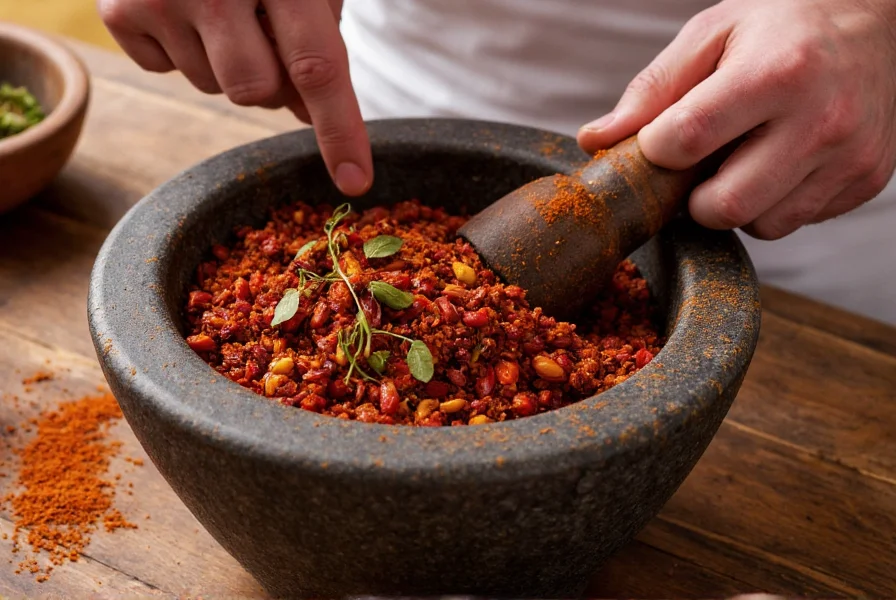When you need a guajillo chili substitute, ancho peppers are the top choice for most recipes, offering a similar mild heat (2,500-5,000 SHU) and rich, fruity flavor with notes of berries and tea. For a closer match in Mexican dishes like moles or salsas, use a 1:1 ratio of dried ancho to guajillo. Pasilla peppers work well for complex sauces, while New Mexico chilies provide a brighter alternative for lighter dishes.
Running out of guajillo chilies doesn't mean compromising your Mexican or Southwestern recipes. Understanding the right guajillo chili replacement requires knowing what makes this dried mirasol pepper unique. Guajillo chilies deliver a distinctive flavor profile—fruity with hints of green tea and berries, moderate heat, and a smooth texture when rehydrated. They're essential in traditional dishes like mole rojo, adobo sauces, and salsas.
Understanding Guajillo Chili Characteristics
Before selecting a guajillo chili substitute, recognize what makes guajillo special. These dried red chilies measure 2,500-5,000 on the Scoville scale—milder than cayenne but with more complexity than bell peppers. Their flavor combines tangy fruitiness with earthy undertones and subtle floral notes. When reconstituted, they create a smooth, almost creamy base perfect for sauces.
Guajillo chilies appear in two forms: whole dried peppers (most common for cooking) and powdered spice. Whole guajillos work best for creating rich, textured sauces, while the powder offers convenience for quick seasoning. This distinction matters when choosing your guajillo chili replacement strategy.

Historical Evolution of Guajillo Chilies
Understanding the historical context reveals why guajillo's flavor profile is irreplaceable in authentic Mexican cuisine. Key developments shaped its current role:
| Time Period | Development |
|---|---|
| Pre-1500s | Indigenous cultivation in modern-day Jalisco and Zacatecas, primarily for sauces and preservation. |
| 1521-1821 | Spanish documentation noted guajillo's use in adobos and stews, though initially confused with other chilies. |
| 1800s | Regional specialization emerged: Central Mexico adopted guajillo for mole rojo, while Oaxaca favored pasilla. |
| 1940s | Commercial drying techniques standardized guajillo quality, enabling national distribution. |
| 2000s-Present | Global demand surged, creating substitution challenges as authentic guajillo became scarce outside Mexico. |
Source: Chile Pepper Institute at New Mexico State University
Top Guajillo Chili Substitutes Ranked
Not all alternatives work equally well across recipes. Your best guajillo chili substitute depends on whether you prioritize flavor matching, heat level, or availability.
Ancho Peppers: The Closest Flavor Match
Ancho peppers (dried poblanos) represent the most accessible guajillo chili substitute in most grocery stores. While slightly sweeter with prune-like notes, they share guajillo's moderate heat range (1,000-2,000 SHU). Use them in a 1:1 ratio for sauces and stews. For authentic guajillo flavor recreation, add a pinch of cumin to compensate for the missing tea-like notes.
Chefs specializing in Mexican cuisine often recommend ancho as the go-to guajillo replacement for everyday cooking. Their wider availability makes them practical for home cooks seeking reliable guajillo chili alternatives.
Pasilla Peppers: For Complex Sauces
Pasilla peppers (dried chilaca) offer deeper, smokier flavors with raisin-like sweetness. Though darker in color than guajillo's bright red, they provide excellent complexity in moles and adobos. Use a 3:4 ratio (three pasilla for every four guajillo) since pasillas run slightly hotter (1,000-2,500 SHU).
When searching for guajillo chili substitutes for traditional Oaxacan recipes, pasilla becomes the preferred alternative. Their earthy depth complements chocolate-based sauces where guajillo's fruitiness might dominate.
New Mexico Chilies: Brighter Alternative
New Mexico chilies deliver a cleaner, slightly tangier profile with less fruitiness. Their heat level (500-7,000 SHU) varies significantly by crop, so taste before using. Start with a 1:1 substitution ratio, then adjust based on heat intensity.
These guajillo chili alternatives shine in lighter applications like enchilada sauces or marinades where guajillo's pronounced fruitiness might overwhelm delicate ingredients.
| Chili Type | Heat Level (SHU) | Flavor Profile | Best Recipe Applications |
|---|---|---|---|
| Guajillo (reference) | 2,500-5,000 | Fruity, tea-like, berry notes | Mole rojo, adobo, salsas |
| Ancho | 1,000-2,000 | Sweet, prune-like, mild earthiness | Everyday sauces, stews, marinades |
| Pasilla | 1,000-2,500 | Smoky, raisin-like, complex earthiness | Moctezuma mole, adobos, complex sauces |
| New Mexico | 500-7,000 | Clean, tangy, moderate earthiness | Enchilada sauces, lighter marinades |
Context-Specific Substitution Guidelines
Substitute effectiveness varies dramatically by cooking context. These evidence-based boundaries prevent common flavor mismatches:
- Ancho in Mole Rojo: Avoid in authentic Central Mexican mole rojo (source: Culinary Institute of America's Mexican Cuisine Curriculum). Guajillo's bright fruitiness is irreplaceable here; ancho creates overly sweet, one-dimensional sauces.
- Pasilla in Fresh Salsas: Never use in raw salsas—its earthy notes become muddy without slow cooking. Ideal only for mole negro or braised dishes where flavors meld over 2+ hours.
- New Mexico in Bean Dishes: Excellent for refried beans (enhances earthiness) but fails in seafood moles where guajillo's berry notes balance brininess. Always remove seeds for delicate applications.
- Regional Authenticity: For Mexico City recipes, prioritize guajillo or ancho; for Oaxacan dishes, pasilla is non-negotiable. Cross-regional substitutions alter cultural authenticity (per Smithsonian's Food in the USA study).
These boundaries stem from chemical interactions: Guajillo's unique methyl anthranilate compound (responsible for grape notes) degrades differently during cooking than substitutes' dominant vanillin compounds.
Advanced Substitution Techniques
For professional results when using guajillo chili alternatives, consider these chef-recommended approaches:
Combination Substitutes
Create a custom guajillo chili replacement blend by combining two milder peppers. Try equal parts ancho and New Mexico chilies to approximate guajillo's balance of fruitiness and brightness. For recipes requiring guajillo's distinctive tea notes, add a small piece of dried chipotle for smokiness.
Adjusting for Dried vs. Fresh
Most guajillo chili substitutes come dried, but if using fresh alternatives like fresno peppers, adjust quantities. Fresh chilies contain more water, so use 3-4 times the amount of fresh pepper to match dried guajillo's concentrated flavor. Always remove seeds from fresh substitutes to control heat levels.
Texture Considerations
Guajillo's smooth texture when rehydrated affects sauce consistency. When using guajillo chili alternatives like pasilla that develop fibrous strands, strain your sauce through a fine-mesh sieve. For ancho substitutes, blend longer to achieve guajillo's characteristic silkiness.

Common Substitution Mistakes to Avoid
Even experienced cooks make these errors when seeking guajillo chili substitutes:
- Ignoring regional variations: Guajillo chilies from different Mexican regions vary in heat. Match your substitute to your recipe's origin—use pasilla for Oaxacan dishes, ancho for Central Mexican recipes.
- Overcompensating with heat: Guajillo's moderate heat means substituting with hotter chilies like arbol creates imbalance. If using hotter alternatives, reduce quantity by 25-50%.
- Misjudging rehydration time: Guajillo softens in 20 minutes; some substitutes like New Mexico require 30+ minutes. Under-soaked peppers create gritty sauces.
When to Seek Specialty Alternatives
For authentic guajillo flavor in critical applications like competition-level mole, consider these less common guajillo chili alternatives:
Mulato peppers provide deeper chocolate notes ideal for complex moles. Cascabels offer nutty undertones perfect for bean dishes. For vegan cooks needing guajillo chili substitutes without nightshade ingredients, roasted red pepper powder with a touch of smoked paprika creates a surprisingly close approximation.
Remember that proper storage affects substitute quality. Keep dried chili alternatives in airtight containers away from light. Most maintain peak flavor for 6-12 months—older chilies lose their nuanced flavors, making accurate guajillo recreation difficult.











 浙公网安备
33010002000092号
浙公网安备
33010002000092号 浙B2-20120091-4
浙B2-20120091-4